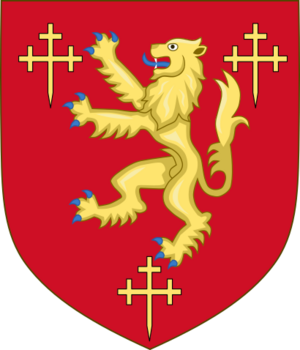Arthur Capell, 1st Earl of Essex facts for kids
Quick facts for kids
The Earl of Essex
|
|
|---|---|

Portrait by Peter Lely
|
|
| Chief Minister of Great Britain First Lord of the Treasury |
|
| In office 1679–1679 |
|
| Preceded by | The Earl of Danby |
| Succeeded by | The Earl of Rochester |
| Lord Lieutenant of Ireland | |
| In office 1672–1677 |
|
| Preceded by | The Lord Berkeley of Stratton |
| Succeeded by | The Duke of Ormonde |
| Personal details | |
| Born | c. 1631 Hadham Hall, Little Hadham, Hertfordshire. |
| Died | 13 July 1683 Tower of London, London, England. |
| Nationality | English |
| Spouse | Lady Elizabeth Percy |
| Children | Algernon Capell, 2nd Earl of Essex Anne Capell, Countess of Carlisle |
| Parents | Arthur Capell, 1st Baron Capell of Hadham Elizabeth Morrison |
| Residence | Cassiobury House |
Arthur Capell, 1st Earl of Essex, also spelled Capel, was an important English statesman. He was born around 1631 and passed away on July 13, 1683. He lived at Cassiobury House in Watford, Hertfordshire.
Contents
Early Life and Youth
Arthur Capell was the son of Arthur Capell, 1st Baron Capell of Hadham. His mother was Elizabeth Morrison. She was the daughter of Sir Charles Morrison, 1st Baronet from Cassiobury House. Arthur was baptized on January 2, 1632.
When he was 16, in June 1648, soldiers took him from Hadham to Colchester, England. His father was defending Colchester at the time. The soldiers hoped that seeing his son would make his father surrender.
Political Career
After the monarchy was brought back in 1660, Arthur Capell was given the titles of Viscount Malden and Earl of Essex in 1661. He also became the Lord Lieutenant of Hertfordshire and later of Wiltshire.
He quickly showed that he disagreed with the King's court. He was against Roman Catholicism and the King having too much power. King Charles II saw him as a strong-willed person who stuck to his beliefs.
In 1669, he became an ambassador to King Christian V of Denmark. He earned respect by refusing to lower his flag to the governor of Kronborg. This showed his strong character.
In 1672, he became a Privy Councillor and the Lord Lieutenant of Ireland. This meant he was the King's main representative in Ireland. He was known for being fair and honest in this role. He worked hard to understand Ireland's needs. He chose good people for important jobs. He also tried to stop the King from giving away Irish lands to his friends.
He had disagreements with Lord Ranelagh over money matters. Arthur Capell was very careful with public funds. This honesty sometimes caused problems with others who were not as strict. Because of these issues and other political reasons, he was called back from Ireland in 1677.
After returning, he joined the group that opposed the King's government. He became a commissioner of the treasury in 1679. He was a good choice for this role because of his experience with money in Ireland. He tried to balance the country's finances.
Arthur Capell often sided with those who wanted to limit the King's power. He supported the Prince of Orange as a leader for Protestants. This put him against some other powerful politicians. He also advised King Charles to call a meeting of Parliament. When the King refused, he resigned from the treasury.
Later, he became worried about the King's brother, James, who was Catholic. In 1680, he supported the Exclusion Bill. This bill aimed to stop James from becoming King. He also spoke out against Catholics during the Popish Plot. However, he tried to help Archbishop Oliver Plunkett, who was accused in a related plot.
Arthur Capell did not support all the extreme plans of his political group. After the Rye House Plot was discovered in 1683, he was arrested. He was imprisoned in the Tower of London.
Rebuilds Cassiobury House
Between 1677 and 1680, Arthur Capell rebuilt Cassiobury House in Watford. This was an old house he inherited from his mother. He hired famous artists and builders for the project. These included the architect Hugh May, the wood carver Grinling Gibbons, and the painter Antonio Verrio. The house was very grand and stood for about 250 more years. It was torn down in 1927.
Family
Arthur Capell married Lady Elizabeth Percy. They had two children:
- Algernon Capell, 2nd Earl of Essex (1670–1710), who became the next Earl.
- Lady Anne Capell, who married Charles Howard, 3rd Earl of Carlisle.
Death
The Earl of Essex passed away in the Tower of London on July 13, 1683. He was a prisoner there.
Legacy
Arthur Capell was known as a very honest and dedicated statesman. He cared deeply about his country. He was hardworking and fair in his public duties. Many people respected him and believed he was a good person. John Evelyn, a famous diarist, described him as "a sober, wise, judicious and pondering person." He also said that few believed Arthur Capell had ever planned anything rebellious. Capel Street in Dublin, Ireland, is named after him.
See also
 In Spanish: Arthur Capell, I conde de Essex para niños
In Spanish: Arthur Capell, I conde de Essex para niños



